| Common name | Binomial name | Population | Status | Trend | Notes | Image |
|---|
| Rough-faced shag (New Zealand king shag) | Phalacrocorax carunculatus | 250-999 [4] | VU [4] |  [4] [4] | Total population estimated to be 350-1,500 individuals. [4] |  |
| Chatham Islands shag | Leucocarbo onslowi | 710 [5] | CR [5] |  [5] [5] | |  |
| Pitt Island shag (Pitt shag) | Phalacrocorax featherstoni | 868 [6] | EN [6] |  [6] [6] | |  |
| Bounty Island shag (Bounty shag) | Leucocarbo ranfurlyi | 874-975 [7] | VU [7] |  [7] [7] | |  |
| Flightless cormorant | Nannopterum harrisi | 2,080 [8] | VU [8] |  [8] [8] | Value provided is for total population. [8] |  |
| Christmas Island frigatebird (Christmas frigatebird) | Fregata andrewsi | 2,400-5,000 [9] | VU [9] |  [9] [9] | Best estimate for breeding population is 3,700 mature individuals. [9] | 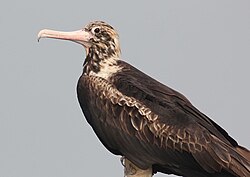 |
| Auckland Islands shag (Auckland shag) | Leucocarbo colensoi | 3,000 [10] | VU [10] |  [10] [10] | |  |
| Stewart Island shag | Leucocarbo chalconotus | 3,300-5,300 [11] | VU [11] |  [11] [11] | Numbers may be overestimated. [11] |  |
| Crowned cormorant | Microcarbo coronatus | 4,324 [12] | LC [12] |  [12] [12] | |  |
| Bank cormorant | Phalacrocorax neglectus | 5,000 [13] | EN [13] |  [13] [13] | |  |
| Abbott's booby | Papasula abbotti | 6,000 [14] | EN [14] |  [14] [14] | |  |
| Campbell Island shag (Campbell shag) | Leucocarbo campbelli | 8,000 [15] | VU [15] |  [15] [15] | Estimate hasn't been updated since 1975. Value given is for total population, but may be more representative of number of mature individuals. [15] |  |
| Oriental darter | Anhinga melanogaster | 10,000-99,999 [16] | LC [16] |  [16] [16] | No formal population estimate has been conducted, but "the population probably numbers at least in the tens of thousands." [16] |  |
| Black-faced cormorant | Phalacrocorax fuscescens | 10,000-99,999 [17] | LC [17] | ? [17] | Total population "probably numbers several 10,000s of birds." [17] |  |
| Ascension frigatebird | Fregata aquila | 17,000-21,000 [18] | VU [18] |  [18] [18] | |  |
| African darter | Anhinga rufa | 17,000-84,400 [19] | LC [19] |  [19] [19] | |  |
| Red-legged cormorant | Poikilocarbo gaimardi | 19,400-20,300 [20] | NT [20] |  [20] [20] | |  |
| Nazca booby | Sula granti | 20,000-49,999 [21] | LC [21] |  [21] [21] | Minimum estimate. [21] | 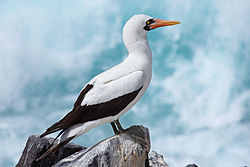 |
| Great pied cormorant (Australian pied cormorant) | Phalacrocorax varius | 23,300-83,300 [22] | LC [22] | ? [22] | Total population is estimated to be 35,000-125,000 individuals. [22] |  |
| Little black cormorant | Phalacrocorax sulcirostris | 23,300-683,000 [23] | LC [23] | ? [23] | Total population is estimated to be 34,999-1,024,999 individuals. [23] |  |
| Japanese cormorant | Phalacrocorax capillatus | 25,000-100,000 [24] | LC [24] | ? [24] | Values given are for total population. [24] |  |
| Indian cormorant | Phalacrocorax fuscicollis | 30,000 [25] | LC [25] | ? [25] | Value given is for total population. [25] |  |
| Anhinga | Anhinga anhinga | 33,300-133,000 [26] | LC [26] | ? [26] | |  |
| Little pied cormorant | Microcarbo melanoleucos | 36,000-201,000 [27] | LC [27] | ? [27] | Values given are for total population. [27] | 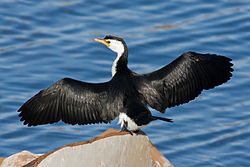 |
| Pygmy cormorant | Microcarbo pygmaeus | 87,300-113,000 [28] | LC [28] |  [28] [28] | | 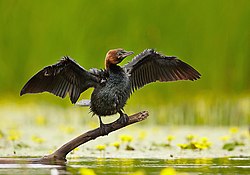 |
| Blue-footed booby | Sula nebouxii | 90,000 [29] | LC [29] |  [29] [29] | |  |
| Lesser frigatebird | Fregata ariel | 100,000-499,999 [30] | LC [30] |  [30] [30] | Values given are for total population. [30] | 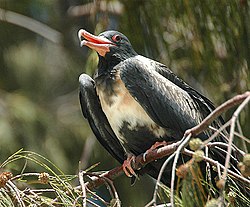 |
| Great frigatebird | Fregata minor | 120,000 [31] | LC [31] |  [31] [31] | |  |
| Magnificent frigatebird | Fregata magnificens | 130,000 [32] | LC [32] |  [32] [32] | |  |
| Long-tailed cormorant (Reed cormorant) | Microcarbo africanus | 134,000-802,000 [33] | LC [33] |  [33] [33] | Total population is estimated to be 200,500-1,202,500 individuals. [33] |  |
| Little cormorant | Microcarbo niger | 183,000-233,000 [34] | LC [34] | ? [34] | Total population is estimated to be 275,000-350,000 individuals. [34] |  |
| Brown booby | Sula leucogaster | >200,000 [35] | LC [35] |  [35] [35] | Minimum estimate. [35] Note that IOC taxonomy splits an additional species, the Cocos booby, from this species. [1] IUCN/BirdLife International maintain both species within S. leucogaster. [36] | 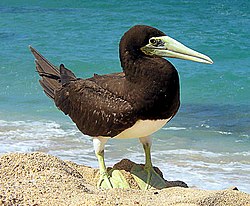 |
| Red-faced cormorant | Urile urile | >200,000 [37] | LC [37] |  [37] [37] | Minimum estimate. [37] |  |
| Socotra cormorant | Phalacrocorax nigrogularis | 220,000 [38] | VU [38] |  [38] [38] | |  |
| Brandt's cormorant | Urile penicillatus | 230,000 [39] | LC [39] |  [39] [39] | Value provided is for total population. [39] |  |
| European shag | Gulosus aristotelis | 230,000-240,000 [40] | LC [40] |  [40] [40] | Values provided are for total population. [40] |  |
| Cape cormorant | Phalacrocorax capensis | 234,000 [41] | EN [41] |  [41] [41] | | 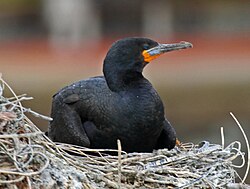 |
| Cape gannet | Morus capensis | 246,000 [42] | EN [42] |  [42] [42] | Mature population only (123,080 pairs). [42] | 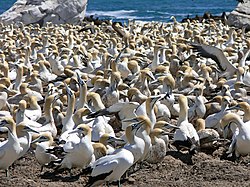 |
| Peruvian booby | Sula variegata | 1,200,000 [43] | LC [43] |  [43] [43] | Values given are for total population. [43] |  |
| Red-footed booby | Sula sula | 1,400,000 [44] | LC [44] |  [44] [44] | Minimum estimate. [44] |  |
| Great cormorant | Phalacrocorax carbo | 1,400,000-2,100,000 [45] | LC [45] |  [45] [45] | Values given are for total population. [45] | 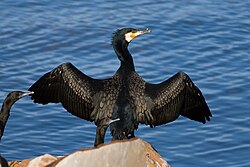 |
| Northern gannet | Morus bassanus | 1,500,000-1,800,000 [46] | LC [46] |  [46] [46] | |  |
| Neotropical cormorant (Neotropic cormorant) | Nannopterum brasilianum | 2,000,000 [47] | LC [47] |  [47] [47] | Values given are for total population. [47] | 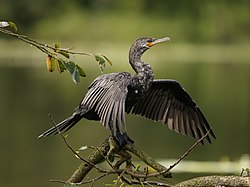 |
| Guanay cormorant | Leucocarbo bougainvilliorum | 2,500,000 – 4,999,999 [48] | NT [48] |  [48] [48] | Values given are for total population. [47] |  |
|






















































